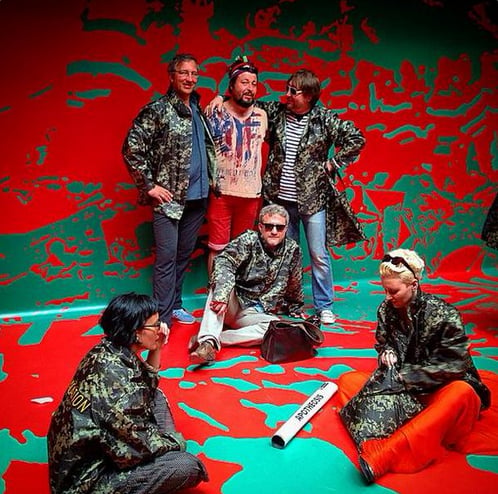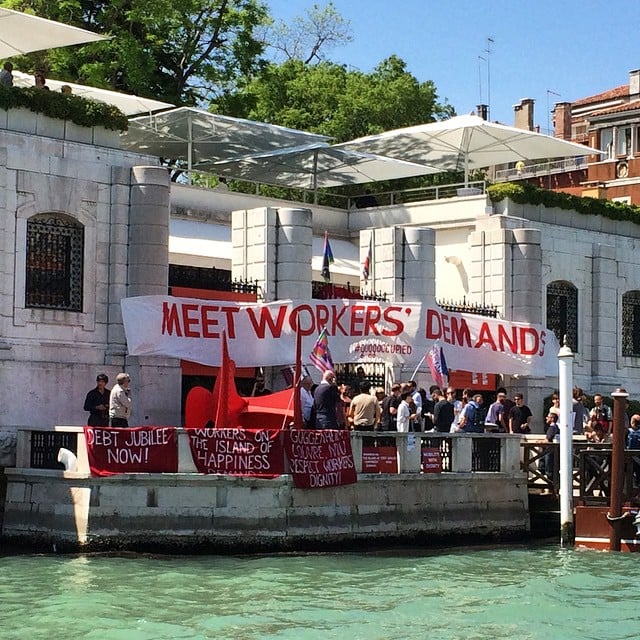Art & Exhibitions
How to Best Navigate the Venice Biennale’s Political and Moral Contradictions
We have devised the ultimate itinerary.

We have devised the ultimate itinerary.

Lorena Muñoz-Alonso


Gulf Labor protesters outside the Peggy Guggenheim Collection in Venice
Photo: luciapizzani via Instagram
Was the incident involving a group of A-listers plunging into the Grand Canal your favorite Venice Biennale preview moment? (See Venice Partygoers Fall Into Canal On Their Way to Fondazione Prada).
Are you feeling critical of all the bling displayed by the hordes of VIPs that descended upon the Italian city last week but, at the same time, a bit jealous of all the dinners and parties you weren’t invited to?
Fear not, you are not alone. The Biennale is (increasingly) a minefield of political and moral contradictions.
Some voices are criticizing the hypocritical political pretensions of the renowned art gathering (see Okwui Enwezor’s 56th Venice Biennale Is Morose, Joyless, and Ugly and Playing Politics: JJ Charlesworth on Why Art World Hypocrisy Stars at the 56th Venice Biennale).
Others, meanwhile, staged subversive interventions and group protests to shed light on very real political issues—while being, to varying degrees, enmeshed in the very tissue they seek to tear apart.
Most people, however, were torn between trying to see as much art as humanly possible, embracing the political themes on display without cynicism, and still manage to get invited to the nth exclusive dinner.
Are you feeling confused about your overlapping selves as risk-free “art activist” and aspirational jet-setter? artnet News has devised the perfect itinerary to let the renegade inside of you make the most of the Venice Biennale. Embrace your inner contradictions.
1. Go to the Icelandic Pavilion, where Christoph Büchel has set up Venice’s first mosque.
The Swiss artist, famous for his controversial large-scale installations, has launched the first mosque to grace the old city center of Venice. His project THE MOSQUE: The First Mosque in the Historic City of Venice seeks to test tolerance in a moment where Islamophobia is on the rise.
That’s all well and good but, unfortunately, the project has been deemed a “public safety threat” by local authorities, which claim the pavilion requires surveillance due to the terrorist threat from extremists (see Venice Police Label Christoph Büchel Art Mosque in Icelandic Pavilion a Public Safety Threat).
2. Re-enact the protest of Gulf Labor at the doors of the Peggy Guggenheim Collection
Last Friday, a group of over 40 protesters from several collectives, including Gulf Labor, Sale Docks, and Macao, gathered at the doors of the Peggy Guggenheim Collection to protest against labor conditions in the Persian Gulf and South Asia (see Gulf Labor Stages Protest at Peggy Guggenheim Collection in Venice).
The activist group Gulf Labor is, in fact, an official participant in the 2015 show, having drawn widespread attention for spectacular protests at the Guggenheim in New York (see Demonstrators at Guggenheim Protest Labor Abuse in Abu Dhabi).
The protests on Friday were so successful that Guggenheim director Richard Armstrong responded by calling Gulf Labor to set up a meeting with museum trustees. The protesters are thus no longer there, but you can go and re-enact their protest solo.

On Vacation takes over the Russian pavilion at the Venice Biennale in protest of the Ukrainian occupation.
Photo: Alisa Ruban, via Twitter
3. Occupy the Russian Pavilion to Protest the Crimean Occupation
Also on Friday, a group of five activists, under the banner On Vacation, took to the Russian Pavilion clad in camouflage outfits to perform a mock occupation. They were protesting the occupation of the Ukrainian peninsula of Crimea in February 2014 by Russian troops (see Ukrainian Activists Occupy Russia’s Venice Biennale Pavilion).
The group is still on site, handing out uniforms to Biennale visitors and encouraging them to occupy various national pavilions in the Giardini, with a particular emphasis on Russia. Find them in the streets of Venice and join their cause, even if only for one day. If you do, you could win a free vacation in a raffle, according to their website. What’s not to like?
4. Attend the rolling readings of Karl Marx’s Das Kapital
This is a tricky one. Whether curator Okwui Enwezor was being earnest or flippant when he programmed the rolling reading sessions of Karl Marx’s Das Kapital as part of an event that could be considered like one of the apexes of capitalism (swanky palazzos, mega-rich collectors, ultra-expensive art, those yachts) is anybody’s guess.
But the fact remains: you can go and listen to a group of performers reading a tome as liberally quoted within art circles as it is seldom actually read. It sounds like the equivalent of watching paint dry, but nobody said being an art renegade was easy.

A-listers take a tumble into Venice’s Grand Canal on their way to a party at Fondazione Prada
Photo via: La Nuova di Venezia e Mestre